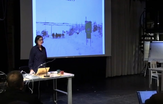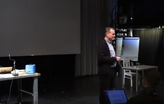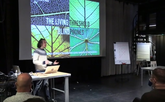VES Seminar 2019:
Unstable constellations
- the spheres of sociotechnical and digital knowledge in performance making.
4.-5.12.2019, University of Arts Helsinki, Theatre Academy,
Degree Programs in Lighting and Sound Design
Within current sociotechnical environments, artists are facing challenges in how to relate to the extremely complex systems and processes that they contain. What kind of knowledge is embedded and can be identified in the digital-technological set-ups facilitating the realisation of an artwork? What do we need to understand on how these systems operate in order to evaluate our agency as artists and our possibility to make choices?
The essence of the qualities of these set-ups are hard to situate or grasp. They operate in a strange spatiotemporal and mnemotechnical dimension having qualities of a space, a tool, an interface, skill, a trace, a script, a program, an algorithm, and so on. The complexity of approaching, dissecting, unboxing or understanding this kind of set-ups and the knowledge(s) embedded in them is made even more difficult by the fact that they gain their sense only in contact to bodies, unfolding in space and time: to bodies operating the setups, situated within the setups, to bodies performing, occupying the stage, to bodies spectating.
Adding to this, these bodies carry within them yet different modalities of knowledge: artistic choices associate often with concept of intuition, or its later definitions as implicit knowledge, which combines a technical dimension of know-how and cognitive models consisting beliefs, perceptions and emotions. Parallel to this, artistic process is also influenced by the sources and references of explicit information. The apparent intersections of different and unstable modalities of knowledge urge us to have a more thorough understanding of the nature of knowing within creative processes.
More info at: https://www.uniarts.fi/vuorovaikutteisuus-esityssuunnittelussa
Opening words by professors Tomi Humalisto and Jari Kauppinen
____________________________
Jukka-Pekka Heikkilä:
Warm data - information that connect dots
Warm Data is transcontextual information. It is information about the interrelationships that connect elements of a complex system. With this information we can try to put the world back together from the fragmented, decontextualized and siloed bits. Information without interrelationality is likely to lead us toward actions that are misinformed, thereby creating further destructive patterns.
Warm Data is a specific kind of information about the way parts of a complex system, such as members of a family, organisms in the oceans, institutions in society, or departments of organisation, come together to give vitality to that system. This kind of information is a slippery mess of variables, changes, and ambiguities. It does not sit nicely in graphs or models, and it takes longer to produce. This new kind of information is needed to balance the information produced by research that decontextualized its subjects of inquiry. In short, the way in which we make sense of the world has everything to do with the way we behave in it.
Jukka-Pekka Heikkilä is a psychologist working with organisations and networks to create new ways of collaborating. He has done research of complex systems and wicked problems and collaborated with artists to find different ways of communicating in the process of becoming.
____________________________
Martina Leeker:
Non-/Knowledge in Performing Posthuman for Resilience
Non-Knowledge became more than sexy in digital cultures. As its technological conditions are based in e.g. speculations, incomprehensible self-organized algorithmic operations, or anticipative techno-human collaborations a being in non-knowledge became a daily experience and a new episteme. Instead of fighting non-knowledge it is integrated in the narrative of resilience, as systems’ capacity to adopt perturbance, being praised as a mode of surviving crisis under the condition of indeterminacy and uncertainty. Performances with technology have a big deal in this turn to resilience as they elaborate on the one hand a more-than-human, techno-ecological existence. Performances with self-organized AI prepare for example resilient imagination, nobilitating uncontrollable techno-human assemblages as a method for enlarging human self-understanding, capable for saving the world. On the other hand “performing posthuman” speculates on posthuman existences, showing unexpected and intriguing resilient transformations, as shown in SciFi-Performances. But, the narratives and practices of non-knowledge and resilience can be seen also as the end of politics in the sense of problem-solving and negotiating sociality. It will be therefore proposed to work in performances firstly on the dark sides of posthuman entanglements, thwarting their allegedly unproblematic and unmediated status. Secondly De-Speculating-Labs will come up with aesthetic formats to de-mystify the politics and regimes of digital non-knowledge, while accepting the constitution of digital cultures in the latter.
Martina Leeker has a background in theatre studies and media studies, as well as in theatre and performance. From 2013 until autumn 2018 she had been Senior-Researcher at the “Centre for Digital Cultures” at Leuphana University Lüneburg. Currently she is a guestprofessor at the Institute of Theatre Pedagogy, University of the Arts Berlin. Her research interests include: Theatre/Performance and Media, Art and Technology, Systems Engineering and Infrastructures, Methods and Critique in Digital Cultures, Performativity, Mimesis and Digitality, Artistic Research. As part of her scientific work, she is building on research with artistic, in particular performative methods (Performing Knowledge and Speculation Labs).
____________________________
Taru Elfving:
Ecologies in/of Practice
How do the understandings and practices of art have to change in response to the societal transformations necessary in the face of climate crisis? Climate crisis if also a crisis of culture, as Amitav Ghosh claims. Environmental matters of concern are inextricable from social, political, and economic forces. The accelerating ecological crisis in its complexity has been acknowledged as deeply interconnected with the entangled histories of extractive capitalism and colonialism. In order to address climate crisis, we thus need to address not only environmental, but also social and mental ecological registers, following Felix Guattari. Measures of carbon footprint are crucial yet insufficient without a thorough reconsideration of the values that guide the methodologies, discourses and structures of the arts. This calls for intersectional politics of aesthetics. We need new alternative genealogies, representations, and narratives that can be achieved through collective and grounded experimentations, as Rosi Braidotti argues. How then to also approach art practices not as they are, but as they may become?
Taru Elfving is a researcher, curator and writer based in Helsinki. Her practice focuses on site-sensitive investigations at the intersections of ecological, feminist and decolonial thought. She is currently developing a multidisciplinary platform for artistic research with the Archipelago Sea Research Institute of Turku University (2017-). Her curatorial projects include Earth Rights (Kunsthalle Turku 2019), Beyond Telepathy (Somerset House 2017), Hours, Years, Aeons (Finnish Pavilion, Venice 2015), Frontiers in Retreat (HIAP 2013-18), Contemporary Art Archipelago CAA (Turku 2011), and Towards a Future Present (LIAF 2008). She has co-edited publications such as Contemporary Artist Residencies(Valiz, 2019), and Altern Ecologies(Frame, 2016). She has a PhD from Visual Cultures, Goldsmiths London (2009) and supervises doctoral students at UniArts Helsinki, where she is also researcher on Sustainable Futures.
____________________________
Hannu Toivonen:
Computational Creativity
Computational creativity is the study of creative systems. It involves the scientific principles and philosophy of creative systems, as well as their engineering and applications. As a research field, computational creativity is in many ways comparable to artificial intelligence. Both aim to give computers the ability to do something valuable in a non-trivial, autonomous manner. There are major differences however: while AI systems typically aim to solve or optimise a given problem, creative tasks typically are open. In this talk, Hannu will give a brief introduction to the field of computational creativity and some of its key concepts and questions.
Hannu Toivonen is a Professor of Computer Science at the University of Helsinki, Finland, since 2002. He works in the areas of artificial intelligence and data science, more specifically in computational creativity and data mining. He has introduced and solved several novel research problems in the area of data mining since the field was born in early 1990s. He has developed applications of data mining for gene mapping, context-aware computation, document analysis and summarization, computational creativity, and natural language generation.
Hannu has 200 scientific publications. According to Google Scholar, he has been cited over 20,000 times. He chaired the IEEE International Conference on Data Mining in 2014 and International Conference on Computational Creativity in 2015. He is Associate Editor of the forthcoming Journal of Computational Creativity. Hannu has acquired external funding for over 6 MEUR, including five EU projects and numerous domestic projects. He holds ten patents.
Hannu’s current research interests revolve around the theory and practice of computational creativity, and self-aware and adaptive software.
____________________________
Andrea Mancianti:
The living threshold/Blindphones:
a material driven attempt to queering sonic immersive experiences.
Immersion, in the last years, is a concept appropriated by and heavily referred to in relation to commercial Virtual Reality and related technology. The commodified nature of such technologies demands the adoption of proprietary strategies exposed to extremely rapid obsolescence, rather close-ended tools and, above all, ideologies that endanger the possibilities of alternative, creative uses of such technology outside of those constraints.
This presentation illustrates the theoretical context and offers an account of the production of the immersive installation Blindphones, an artistic experience presented to Ars Electronica festival 2018. It was conceived as a possible case study to re-appropriate some of the key concepts behind VR, such as re-embodiment and immersion, in alternative to the mainstream corporate discourse. Abandoning any commercial device, it attempted to reimagine the head mounted display as a form of prosthetics radically changing our perception providing a glimpse of an alternative embodiment.
The installation Blindphones was thus experienced through an experimental wearable realised using simple DIY technologies and sustainable materials, build around the sonic and optical properties of large sheets of bacterial cellulose. Rather than as a tool to fool our senses by providing (some of) them with a credible simulation of the world, Blindphones, by heavily impairing sight, forces the body to function using sound as the main sense to articulate a dreamy world made of shifting lights and music.
Andrea Mancianti is a composer, performer, sound and media artist. With his work, that include music compositions, installations and mixed media performances, he seeks to investigate compositional and performative aspects of interconnected audio(visual) ecosystems, where real-word phenomena extend in the digital world and complex feedback networks are established between the two realm.
____________________________
Joris Weijdom:
Designing the site-specific 36Q° Blue Hour VR mixed reality installation.
How performing arts, dramaturgy and expanded scenography informs
XR development and affords embodied strategies for its design.
This talk will show an insider’s view on the design and production of the site-responsive 36Q° Blue Hour VR mixed reality installation that was part of the 36Q° project shown to at least 500 designers at the Prague Quadrennial in June 2019. As part of this project embodied design strategies have been developed, inspired by methods and know-how coming from the performing arts. It illustrates how experience through the body itself can and should be part of a XR design process, and how these strategies facilitate an interdisciplinary dialogue between artistic designers and technical developers.
Joris Weijdom is a researcher and designer of mixed-reality experiences focusing on interdisciplinary creative processes and performativity. He is a lecturer at the HKU University of the Arts Utrecht where he founded the Media and Performance Laboratory (MAPLAB), enabling from 2012 until 2015 practice-led artistic research on the intersection of performance, media and technology. As part of his PhD project, Joris researches creative processes in collaborative mixed reality environments (CMRE) in collaboration with Utrecht University and the University of Twente.
____________________________
Outi Condit, Mikael Brygger, Teemu Määttänen & Jokke Heikkilä:
Gaps, frictions, and clouds? - Practical case study
Last spring we came together to collaborate at the intersection of theatre, game design and VR- technology with the intent of producing both a playable performance demo and pedagogic insights on working across disciplinary difference. At VES 2019 we present a case study of our experience, as well as a sample of the work we made.
Outi Condit is an actor, performance maker, and self-professed pedestrian cyborg, currently in the final stages of their artistic doctorate in the Performing Arts Research Centre, University of Arts Helsinki. Their research was initiated by a sense of wonder at the pliability of bodily self, both as a professional actor/performer and an (in)queering body.
Mikael Brygger is a poet, writer and teacher interested in visual, conceptual, digital and gamified approaches to writing. In addition to writing three books of poetry, Mikael has been involved in several collaborations between poets and visual artists. He is founding member of the publishing house Poesia and visiting Professor in University of the Arts Helsinki.
Teemu Määttänen is a media artist and teacher of digital arts from Helsinki. His interest in manipulating reality through projected images, animation and light started while studying lighting design in the Theatre Academy. He has done installations based on projections in galleries and light festivals. He has worked as a media designer, scenographer and lighting designer in dance and theatre productions since 2006. In 2019 he became the Lecturer of Digital Design Methods in Film, Television and Theatre in Aalto University.
Jokke Heikkilä works as a lecture of digital technologies in performing arts in University of the Arts Helsinki.









